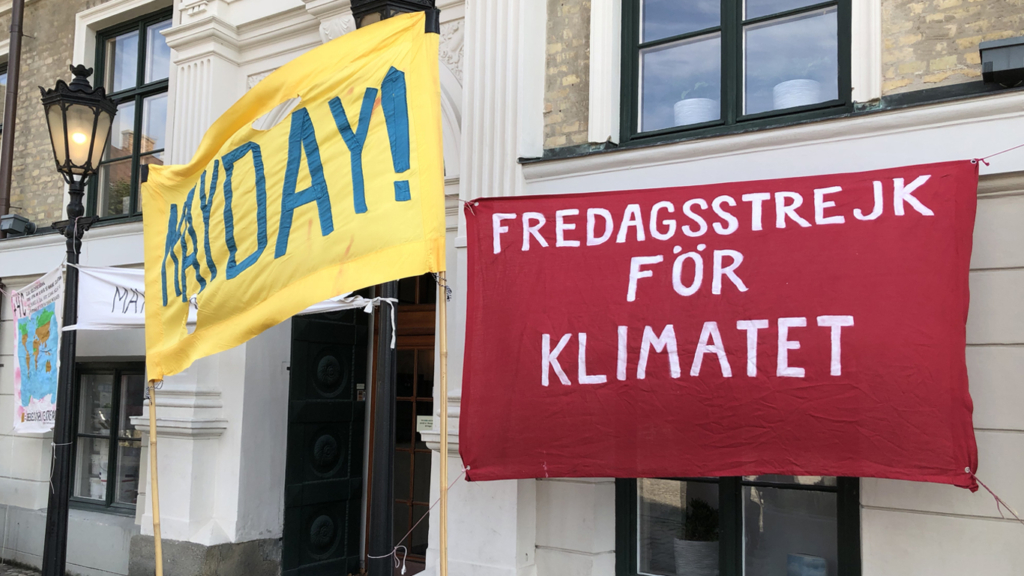Measures to decrease the university’s emissions were in focus as Lund University’s sustainability work was presented online this Wednesday. In a webinar arranged by Climate Students Lund and LU’s Sustainability forum, representatives from the university answered students’ questions regarding the new sustainability plan.
– We envision a university which takes a leading role in the transition towards a sustainable society, and a university that students and employees alike can be proud of.
Those were the opening words of Sigurður Andersson from the student organisation Climate Students Lund. Over one hundred students participated in the online webinar where Lund University’s new sustainability plan, which was approved in November 2020, was discussed. Representatives from the university leadership, the Sustainability forum, and three faculties, each got a chance to answer the central question formed by Sigurður Andersson:
– We ask now: What will you do? Who will be responsible? And how do we produce real change for Lund University?
The sustainability plan which has been coordinated by Claes Nilén, Environmental manager at Lund University, together with Anna Ekberg, coordinator for the Sustainability forum, formulates goals in twelve areas central to the niversity’s sustainability work.
As Claes Nilén presents the status of goals in the areas, the matrix flashes by in yellow–the colour of ongoing measures. Mapping the current waste management: yellow. Reusability of furniture: yellow. Establishment of a climate balance: yellow.
Four of the areas are also partly marked with green, a colour that marks achievement. Two of the green boxes read “environmental requirements in catering in place”, and “investment regulation with social responsibility”. Apart from a goal regarding chemical safety, only one area is marked with red: Climate.
– In each procurement, and in each decision and activity, we have to take into account the consequences for the climate, says Claes Nilén.
According to Claes Nilén, one important step in decreasing the university’s carbon-footprint is to measure the emissions. A climate balance will therefore be established during the year, mapping out the university’s emission. Drawing knowledge from other universities, Clas Nilén estimates that travels by air under normal circumstances could stand for about 40 percent of the university’s emissions.
Because of the pandemic the number of flights last year were reduced with 86 percent compared to 2019. In order to reach the climate goal of reducing the greenhouse gas emissions by half from 2018 to 2023, Clas Nilén notes that more measurements have to be made.
– We still need to analyse traveling patterns, and create a project around that.
The suggestion of a flight budget – similar to a carbon budget – suggested by a student, was met with uncertain reactions from the representatives. The faculty’s self governance was brought into focus as the discussions revolved around whether the plan should focus on attitude measures or enforcement from the central leadership. Christofer Edling, dean at the Faculty of Social science argued that some enforcements should be made on a central level.
–I think it would be good if the university just didn’t make it possible to buy a flight ticket to Stockholm for instance. That would be an easy decision to make. It would piss people off for a couple of months until everybody forgot about it. But it’s a sensitive issue. Decentralisation is part of the identity of the university and it doesn’t always serve us well.
Maria Johansson, vice dean at Faculty of Engineering, LTH, notes that working with students and employees attitudes is equally important.
– We could infuse something with force from a top down perspective, but equally important is to have a bottom up process. To have each individual researcher and student embrace the sustainability perspective and identify what is possible to do by them, she says.
Pro Vice-Chancellor Per Mickwitz also stresses the importance of the university’s positive sustainability. He brings up examples of the university’s handprint – the positive effect the university can have on sustainability – where education and research are key areas. To increase the university’s handprint, a sustainability fund will be established this year, which will support innovative solutions.
– We will be a force for sustainable development. You ask who is responsible, and who is in charge: I think we will all be. But the new leadership, and especially I, will certainly use all my time awake for this purpose, he says.









